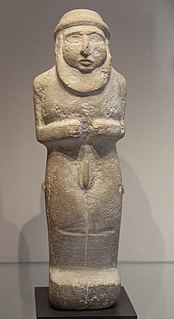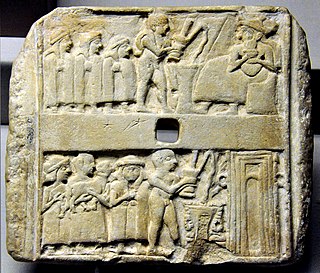
The Lament for Uruk, also called the Uruk Lament or the Lament for Unug, [1] is a Sumerian lament. It is dated to the Isin-Larsa period. [2]

The Lament for Uruk, also called the Uruk Lament or the Lament for Unug, [1] is a Sumerian lament. It is dated to the Isin-Larsa period. [2]
The Lament for Uruk is one of five known Mesopotamian "city laments" — dirges for ruined cities in the voice of the city's tutelary goddess, recited by elegists called gala. [3] It was inspired by the Lament for Ur. [4]
First written in c. 1940 BCE, [5] the Lament was recopied during the Hellenistic period, when Babylonia had again been overrun by foreigners. [6] [7]

The Lament is 260 lines long, being composed of 12 kirugu (sections, songs) and 11 gišgigal (antiphons). [8]
Numbered by kirugu, the lament is structured as follows:
It is composed in the standard emegir dialect of Sumerian. [10]

Eridu is an archaeological site in southern Mesopotamia. Eridu was long considered the earliest city in southern Mesopotamia. Located 12 km southwest of Ur, Eridu was the southernmost of a conglomeration of Sumerian cities that grew around temples, almost in sight of one another. These buildings were made of mud brick and built on top of one another. With the temples growing upward and the village growing outward, a larger city was built. In Sumerian mythology, Eridu was originally the home of Enki, later known by the Akkadians as Ea, who was considered to have founded the city. His temple was called E-Abzu, as Enki was believed to live in Abzu, an aquifer from which all life was believed to stem.

Inanna is an ancient Mesopotamian goddess of love, war, and fertility. She is also associated with beauty, sex, divine justice, and political power. She was originally worshiped in Sumer under the name "Inanna", and later by the Akkadians, Babylonians, and Assyrians under the name "Ishtar". She was known as the "Queen of Heaven" and was the patron goddess of the Eanna temple at the city of Uruk, which was her main cult center. She was associated with the planet Venus and her most prominent symbols included the lion and the eight-pointed star. Her husband was the god Dumuzid and her sukkal, or personal attendant, was the goddess Ninshubur.

The history of Sumer spans the 5th to 3rd millennia BCE in southern Mesopotamia, and is taken to include the prehistoric Ubaid and Uruk periods. Sumer was the region's earliest known civilization and ended with the downfall of the Third Dynasty of Ur around 2004 BCE. It was followed by a transitional period of Amorite states before the rise of Babylonia in the 18th century BCE.

Lugal-Zage-Si of Umma was the last Sumerian king before the conquest of Sumer by Sargon of Akkad and the rise of the Akkadian Empire, and was considered as the only king of the third dynasty of Uruk, according to the Sumerian King List. Initially, as king of Umma, he led the final victory of Umma in the generation-long conflict with the city-state Lagash for the fertile plain of Gu-Edin. Following up on this success, he then united Sumer briefly as a single kingdom.

Lugalbanda was a deified Sumerian king of Uruk who, according to various sources of Mesopotamian literature, was the father of Gilgamesh. Early sources mention his consort Ninsun and his heroic deeds in an expedition to Aratta by King Enmerkar.

The Lament for Ur, or Lamentation over the city of Ur is a Sumerian lament composed around the time of the fall of Ur to the Elamites and the end of the city's third dynasty.
Aratta is a land that appears in Sumerian myths surrounding Enmerkar and Lugalbanda, two early and possibly mythical kings of Uruk also mentioned on the Sumerian king list.

Ibbi-Sin, son of Shu-Sin, was king of Sumer and Akkad and last king of the Ur III dynasty, and reigned c. 2028–2004 BCE or possibly c. 1964–1940 BCE. During his reign, the Sumerian empire was attacked repeatedly by Amorites. As faith in Ibbi-Sin's leadership failed, Elam declared its independence and began to raid as well.

Sumerian literature constitutes the earliest known corpus of recorded literature, including the religious writings and other traditional stories maintained by the Sumerian civilization and largely preserved by the later Akkadian and Babylonian empires. These records were written in the Sumerian language in the 18th and 17th Centuries BC during the Middle Bronze Age.

Dumuzid titled the Fisherman was a legendary Sumerian king of Uruk listed originating from Kuara. According to legend, in the one-hundredth year of his reign, he was captured by Enmebaragesi.

Aga (Sumerian:𒀝𒂵) commonly known as Aga of Kish, was the twenty-third and last king in the first dynasty of Kish during the Early Dynastic I period. He is listed in the Sumerian King List and many sources as the son of Enmebaragesi. The Kishite king ruled the city at its peak, probably reaching beyond the territory of Kish, including Umma and Zabala.

Ninisina was a Mesopotamian goddess who served as the tutelary deity of the city of Isin. She was considered a healing deity. She was believed to be skilled in the medical arts, and could be described as a divine physician or midwife. As an extension of her medical role, she was also believed to be capable of expelling various demons. Her symbols included dogs, commonly associated with healing goddesses in Mesopotamia, as well as tools and garments associated with practitioners of medicine.

Sumerian religion was the religion practiced by the people of Sumer, the first literate civilization of ancient Mesopotamia. The Sumerians regarded their divinities as responsible for all matters pertaining to the natural and social orders.

Self-praise of Shulgi is a Sumerian myth, written on clay tablets dated to between 2100 and 2000 BC.

The Song of the hoe or the Creation of the pickax is a Sumerian creation myth, written on clay tablets from the last century of the 3rd millennium BCE.

Būr-Sîn, c. 1831 – 1811 BC or c. 1895 – 1874 BC was the 7th king of the 1st Dynasty of Isin and ruled for 21 years according to the Sumerian King List, 22 years according to the Ur-Isin king list. His reign was characterized by an ebb and flow in hegemony over the religious centers of Nippur and Ur.

The lament for Sumer and Urim or the lament for Sumer and Ur is a poem and one of five known Mesopotamian "city laments"—dirges for ruined cities in the voice of the city's tutelary goddess.

Kindattu was the 6th king of the Shimashki Dynasty, in Elam, at the time of the third dynasty of Ur in ancient Lower Mesopotamia.

Lugal-kisalsi, also Lugaltarsi was a King of Uruk and Ur who lived towards the end of the 25th century BCE, succeeding his father Lugal-kinishe-dudu, according to contemporary inscriptions, although he does not appear in the Sumerian King List. In one of his inscriptions, he appears as "Lugalkisalsi, the first-born son of Lugalkigenedudu, king of Uruk and Ur".

The Lament for Nippur, or the Lament for Nibru, is a Sumerian lament, also known by its incipit tur3 me nun-e. It is dated to the Old Babylonian Empire. It is preserved in Penn Museum on tablet CBS13856.